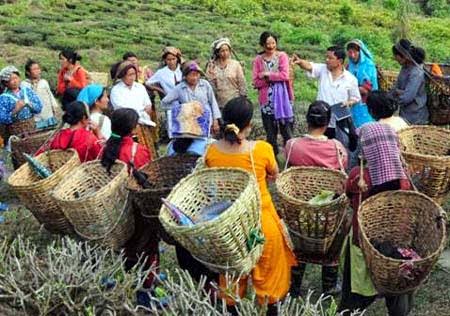Darjeeling Tea history – British tea expert Malcolm Ferris-Lay narrated a history of intrigue and industrial espionage in 1848 when the East India Co. sent a spy to China to smuggle out tea plants. These were later planted in Darjeeling and came to be globally famous as the unique “Darjeeling Tea”.
 |
| Tea Planter with Tea Pickers, Steinthal Tea Estate 1930s |
Since 1664, East India Co did a flourishing trade in exporting opium to China and bringing in shipments of tea to India. In the 1680’s, a pound (454 gm) of tea cost $6 which at current exchange rate would mean £ 1068 for a pound of tea. Robert Fortune, a daring young man born in Scotland, was roped in by the British in May 1848 to collect information from China on tea industry.
Robert Fortune disguised himself as a Chinese, with a shaven head and pigtails, from a distant province, learned Mandarin and secretly entered Fujian and Jiangsu, which were forbidden to foreigners. He managed to collect 20,000 plants and seedlings and ship out to Kolkata by sea. The knowledge gained by Fortune and the seedlings planted in Tukvar in Darjeeling were instrumental in setting up the remarkable Darjeeling tea brand.

According to an expert in ITA, the product is identical to the tea grown in China with the difference that Chinese green tea is steamed and dried. The liquor is greenish and yellowish and light. On the other hand, Darjeeling tea is fermented and roasted. It has a brown-ochre colour and smoky flavor.
Ref. : THE ASSAM REVIEW & TEA NEWS, 26TH Feb. 2014
Vo. : 102 No. 12
[Courtesy: Sangam Rai]
Source : DT
SIMILAR ARTICLES
सम्पूर्ण चिया कमानहरुमा काम बन्द गर अनि श्रमिकहरुलाई बन्द अवधीको वेतन देऊ! DTA अनि CCPA को दार्जीलिङ पहाड़को चियाकमानहरुमा काम संचालित राख्ने कोशिशको घोर निन्दा गरौं! विश्वलाई त्रासित बनाएको कोरोना भाइरसको महामारी विरुद्ध हर एक देश अनि संस्थाहरु एकबद्ध भएर सक्रिय रुपमा काम गरिरहेका छन्। हाम्रो देशमा पनि यो भाइरसको विस्तारलाई रोक्नको निम्ति सरकारले कतिपय […]
Shut Down Plantations and Pay Wages to the Workers. Darjeeling Tea Association and Consultative Committee of Plantation Association has turned deplorable and inhuman by shamelessly requesting the West Bengal State Government to allow the complete operation of Tea Plantations in Darjeeling as reported in the Statesman on 27th March 2020. How indifferent, insensitive and self- […]
As you sip your favourite Darjeeling tea planning how to enjoy this festive season, tea garden workers in Darjeeling are on a hunger strike for a 20% annual festive bonus. A 12 hour bandh has also been called in Darjeeling Hills tomorrow. Union leaders plan to hold hunger strikes ‘in front of garden offices’ from […]
Darjeeling MP Raju Bista has been elected as one of the members of the Tea Board of India. When he was asked by a journalist about his further course of action after being elected, he responded as follows: “As you are aware the Darjeeling Hills, Terai and Dooars along with neigbouring Assam produce some of […]







